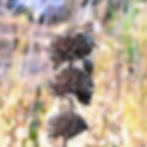OR Letting Your Rewilded Yard to Go To Seed
Thanks to my ongoing naturescaping (landscaping to coexist with nature) my yard is attractive to wildlife and appreciative people. Ecologically friendly cues to care explain intentionality and show the ways I'm welcoming wildlife for anyone who takes the time to look at what's going on.

My yard gets a glow up during the growing season from all the blooming plants, birds, bumblebees, and butterflies but in the fall and winter when shades of brown take over, the beauty of rewilding is a little less obvious in a lawn centered neighborhood. Over time, I've become less of an apologist for the aesthetic of my ecologically informed yard and more of an advocate. I see it as just one example in a continuum of how to elevate the function of our yards and change the paradigm of what a yard "should" look like. Controlled neat and tidy landscaping is out - authentically wild and vibrant landscaping is in.


Leaving seedheads for wildlife is just one of the multiple habitat support elements in my yard yet calling my yard a birdseed garden is just one of many ways I might explain its value to the uninformed at at time when it's natural enough to attract birds plus the interest from people walking by, yet not wild looking enough (just yet!) for neighbors to think I'm letting things go to seed...when in fact this is exactly what I'm doing.

To help anyone who is leaving the stems and seedheads standing all year for to make their yard more habitat friendly for wildlife, I've distilled the hundreds of native plants growing in my yard into a highly subjective human centered list of 25 native plant picks to frame a rewilded yard as a birdseed garden. The trick is finding native plants that offer both a variety of seed sources for birds (and other wildlife) and are interesting to look at even in the dead of winter when the last seeds have already been eaten. Many of the seedheads will degrade over time as birds and other wildlife enjoy them - this is a feature, not a bug of a rewilded yard. The evidence tells a story of the benefit it offers.

The plants listed are native to the Piedmont ecoregion where I live - to offer the greatest habitat support, try to add the species native to your ecoregion. For more biodiversity, plant multiple species - for example, the different asters and goldenrod growing in my yard ensure blooms from summer through frost and have slightly different seedheads.

My list favors the more common and easier to find native plants. Unlike the ornamental gardening culture of possessing the most unique and hard to find plant, coexisting with nature is about figuring out what the most useful plants for wildlife might be where you live which are often the most abundant one. Even a small sunny patch of a half dozen native plants from this list would go a long way towards helping nurture nature in your yard's ecosystem throughout the year.
25 Native Plants to Add to Your Bird Seed Garden

























Marshallia trinervia (Broadleaf Barbara’s Buttons) is also structurally interesting. It's an easy, slow grower for me, but it isn't the biggest birds magnet and I'm not sure it's readily available - so I'm not including it in the list. If you find it at a native plant nursery or grow it from seed, add it as a plant you will smile when you see in your yard - the flowers are also lovely.

.jpg)
